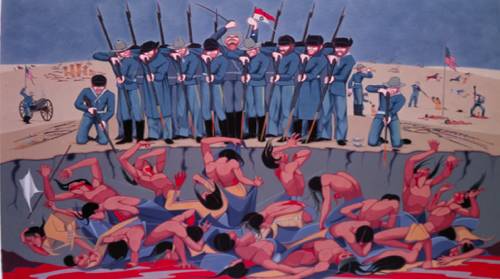Wounded Knee Massacre, Oscar Howe, Flickr
Every schoolchild learns how Thanksgiving started. The Pilgrims landed at Plymouth Rock in December of 1620. Their first winter was devastating, never mind the horrible passage from England. The survivors were aided by local indigenous people who taught them how to fish and plant corn. By the time their first harvest came around, the Pilgrims were so grateful for their native neighbors’ aid, they invited them to join in a harvest celebration, and thus was born Thanksgiving.
Yet, within sixteen years, the Pilgrims were at war with the Indians; 600 Pequot were massacred in 1637. Battles between white men and red men continued for over two centuries, culminating in the Wounded Knee Massacre in South Dakota, 1890.
Stone Fever is a similar tale of first contact, but with a twist. Three hundred years into the future, a young Cree Indian geologist is exploring for a valuable mineral in ice-free Antarctica, after a Canadian industrialist has dangled fame and fortune in front of her. What she and her crewmates discover is a tribe of nomadic cattle-herders. Keltyn soon deduces that her mission will disrupt the welfare of this tribe, and plunges headlong into a frantic attempt to reverse course.

